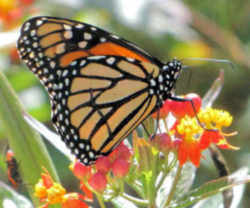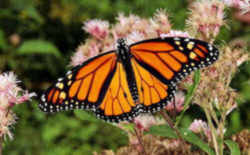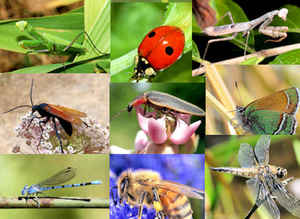Illinois State Insect
Monarch Butterfly

(Danaus plexippus)
Adopted on October 1, 1975.
The monarch, (Danaus plexippus,) was chosen on October 1, 1975 to be Illinois' state insect. The third grade classes at Dennis School in Decatur originally recommended the species. The class proposed the orange and black Monarch Butterfly as the State's Official Insect. Rep. Webber Borchers of Decatur introduced a bill in the General Assembly, and the schoolchildren lobbied for its passage. In 1975, the bill passed, and the Dennis School class watched Gov. Daniel Walker sign it into law.
Did you know that: The Monarch Butterfly has been proclaimed the official state insect or butterfly in each of the following states:
Minnesota | Texas | Vermont | West Virginia
Illinois State Insect: Monarch Butterfly

Monarch butterflies are commonly found in Illinois from May through October. Monarchs living east of the Rockies (including those from Illinois) spend the winter in a mountainous area in central Mexico, some leaving as early as August to begin this 2000-mile flight. The western monarchs winter along the coast of California near Monterey. Coming to rest in the evening, the butterflies cluster together on foliage of trees and shrubs.
Characteristics of the Monarch Butterfly
In Spring when the female butterflies migrate northward, they lay eggs on various species of milkweed. The development period from the egg through larva and chrysalis to the adult ranges from 20 to 33 days. The development time depends on temperature (faster in warmer areas). Some monarchs remain in the vicinity of their breeding grounds; others fly north to lay eggs.
The monarch undergoes four changes in form (metamorphoses) during its lifetime. It begins as a tiny egg. In its second stage it becomes a black, yellow and white striped caterpillar (larva). During this stage, the monarch caterpillar sheds its skin (molts) up to four times as it grows to its full length of about 2 inches. The monarch larva feeds only on the milkweed plant. Luckily for the larvae, the juices of the milkweed make the larvae taste terrible to birds and they rarely get eaten. In the third stage, the monarch forms a protective covering called a chrysalis (pupa). This pupa is shiny and green with gold speckles. During this time the monarch undergoes its final change. When it emerges from its sac, out comes a beautiful black and orange monarch butterfly. This entire process takes about a month. There are usually three to four generations of monarchs produced each year.
While most insects hibernate, the monarch is the only species of butterfly which actually flies to warmer weather (migrates) in winter. Monarchs from Illinois spend their winters in California and Mexico. In the fall, people have reported seeing entire trees covered with thousands of migrating monarchs! However, only about 1 percent of these monarchs actually survive the journey back to Illinois.
Illinois Law
The law designating the Monarch Butterfly as the official Illinois state insect is found in the Illinois Compiled Statutes, Government, Chapter 5, State Designations Act, Section 15.
GOVERNMENT
GENERAL PROVISIONS (5 ILCS 460/) State Designations Act.
(5 ILCS 460/15) (from Ch. 1, par. 2901-15)
Sec. 15. State insect. The insect Danaus plexippus, commonly known as the "Monarch Butterfly", is designated the official
State insect of the State of Illinois.
(Source: P.A. 87-273.)
Taxonomic Hierarchy: Monarch Butterfly
Kingdom: Animalia (Animals)
Phylum: Arthropoda (Arthropods)
Subphylum: Hexapoda (Hexapods)
Class: Insecta (Insects)
Order: Lepidoptera (Butterflies and Moths)
Superfamily: Papilionoidea (Butterflies and Skippers)
Family: Nymphalidae (Brush-footed Butterflies)
Subfamily: Danainae (Milkweed Butterflies & Glasswings)
Tribe: Danaini (Milkweed Butterflies)
Genus: Danaus
Species: plexippus (Monarch - Hodges#4614)
Butterflies, and Bugs








